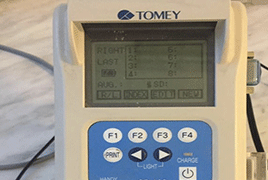The objective of the study was to determine whether there exists a difference in the central cornea thickness (CCT) in patients with hypertensive (HTG) and normotensive glaucoma (NTG), and subsequently, to compare the application of prostaglandins by corrected CCT (CCT correction) for both types of glaucoma.
Material and methods: 100 eyes of 50 patients (the average age of 67) with HTG and 100 eyes of 50 patients (the average age of 62.6) with NTG were examined. Antiglaucomatics, if indicated, were taken by the patients for at least the preceding five years. The excluding criteria in the study were: cornea diseases, post-laser procedure conditions and high ametropia. CCT was measured by means of Tomey Handy Pachymeter SP100 by the same physician.
Results: A two-sample t-test was applied in order to compare the measurement values of CCT and the subsequent correction of these values (CCT correction) in patients with HTG and NTG. The statistical evaluation showed that in case of both CCT and CCT correction, the values were lower in the group of NTG patients in comparison with HTG patients. With respect to CCT, the difference was statistically insignificant (NTG 554.9±35.7 vs. HTG 561.4 ± 32.7, p = 0.181). In case of CCT correction, the difference was more considerable, but still statistically insignificant (NTG 550.8 ± 35 vs. HTG 559.6 ± 33.1, p = 0.06).
Conclusion: CCT was higher in NTG than in HTG; however, these values were statistically insignificant. A comparison of the application of prostaglandins of corrected CCT (CCT correction) for both types of glaucoma increased the difference, but this difference was still statistically insignificant. This difference was caused by an uneven representation of patients treated with prostaglandins in both groups.

